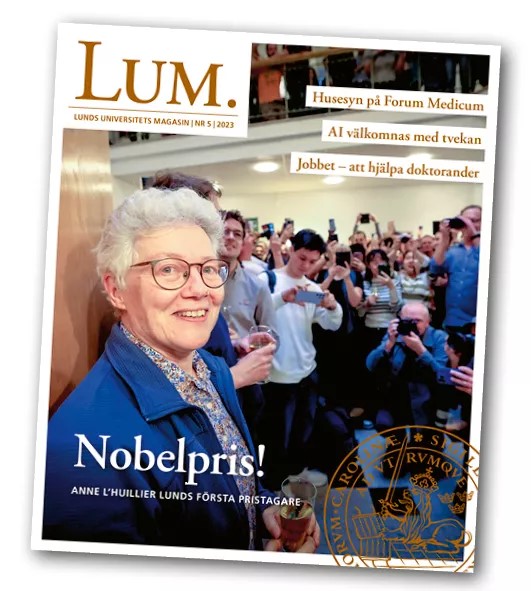One person’s workplace, another’s home
How long does it take to comfort someone? Does an egg need to be fried rather than boiled? Lund University Magazine (LUM) invited home care researchers from the School of Social Work and the Faculty of Engineering (LTH) for a conversation. They are meeting for the first time; their discussions cover stress, responsibility and participation. Their common goal is better home care, but they approach the issue from different perspectives.
Jessika Sellergren – Publicerad den 26 oktober 2023

Coffee and cake are laid on in the meeting room. The ‘fika’ is intended as an icebreaker but it turns out not to be needed – the researchers start chatting straight away.
The researchers from the School of Social Work visiting the Faculty of Engineering (LTH) are Håkan Jönson, Tove Harnett and Glenn Möllergren. Their studies are about older people, ageing and what living with elderly care is like. They are of the opinion that the users of home care services are often overlooked within research.
The LTH researchers, for whom the meeting is a home fixture, are Gerd Johansson, Christofer Rydenfält and Roger Larsson. They are investigating what it is like to work within elderly care, from the perspective that work environment research is necessary in order for home care to work more effectively.
Despite their differing approaches, the researchers agree that home care needs to be improved – both for the elderly and for those working.
A battle for time
Gerd Johansson is a veteran of research into the work environment of home care. She has been studying work environments in healthcare since the 1990s, and home care since 2014. She explains that the work of home care has always been heavy and stressful, but that it has become even tougher in recent years.
“More and more people are living longer and developing increasingly demanding care needs that are to be met in the home. At the same time, staff are to manage more home visits in a shorter space of time. The scheduling is tight, and workers are in a constant race against time.
She finds agreement from Håkan Jönson, elderly care researcher since the late 1990s and another veteran in the area. He goes on to argue that the race against time also affects older people at home.
“Within home care, the staff are very much governed by timings and how much time each care task is allowed to take. The time allotted rarely takes into account the fact that a service in the home is an interaction between the staff member and the user of the service, and as a result the time needed can vary. After all, how do you actually calculate how long it takes to comfort someone?
Fried eggs instead of boiled
This interaction is also reflected in the fact that users of home care services make changes to their daily routines in order to try and reduce the stress on staff. That is clear from the interviews that Glenn Möllergren has conducted with older people who use home care.
“A large proportion of their waking hours is spent preparing and waiting for the staff’s visits,” he says, before listing a few examples of adaptations made:
Choosing a fried egg instead of boiled, because it is quicker to prepare – despite the older person actually preferring boiled eggs. Putting on clothes that are easier for staff to deal with – even though they want to wear other clothing. Refraining from practicing their leisure activities since the user of home care services knows that they can only get help in walking to the park, not to watch a football match.
Home care also "work environment for the elderly"?
The interaction between the users of the service and staff makes the older people an unacknowledged part of the workforce. Tove Harnett calls home care “older people’s work environment.”
Christofer Rydenfält, though, thinks that the message gets confused and that real work environment problems are obscured if it is not clear whose work environment we are dealing with.
“If we want to have home care in the future in which the positive interaction between the service user and staff is put to good use, then changes are necessary that make home care an attractive and well-functioning workplace where people want to work and have the energy to do so.
Today, home care staff are among the largest groups of workers in Sweden.
“They are also one of the most vulnerable groups, with a large turnover of staff and lots of managerial changes, which is bad for the users of home care services and for the staff,” says Christofer Rydenfält.
”A dangerous game”
But despite the increasing need for adequate home care, cuts and austerity measures that affect home care are implemented.
“The resources become fewer, the conditions poorer, and yet both staff and users of the service do what they can to help and make things easier. I think it is a dangerous game that is being played,” says Håkan Jönson.
Tove Harnett can also see risks:
“The users of the service do not see their entitlements being met but instead of saying they have the right to more, they express understanding of the fact that the staff have a hard and stressful time, which gives legitimacy to this unhealthy game.
Christofer Rydenfält prefers to call the game a coping strategy:
“Both staff and users of the service cling to what is positive and what works despite the staff’s needs for better conditions and the fact that users of the service should be able to expect more.”
The coffee is finished, but the conversation continues
With the coffee drunk, the time has come to round off the conversation. Despite the empty cups, however, the discussion continues. Before leaving, the researchers exchange contact details so that they can get together again.
Who knows, perhaps one person’s workplace, another’s home can be understood in new ways through an interdisciplinary approach?
Gerd Johansson is hopeful:
“The quality of care and the work environment are two sides of the same coin. When one part is improved, the other one is too.

The article is originally published in LUM, Lund University Magazine, 5/2023
One person’s workplace, another’s home | Staff Pages (lu.se)

Gerd Johansson
Gerd Johansson, professor emerita in Working Environment at the Faculty of Engineering
Gerd Johansson — Lund University

Håkan Jönson
Håkan Jönson, Professor in Ageing and Eldercare at the School of Social Work
Håkan Jönson — Lund University

Glenn Möllergren
Glenn Möllergren, PhD Student in Ageing and Eldercare at the School of Social Work
Glenn Möllergren — Lund University

Tove Harnett
Tove Harnett, Senior lecturer in Ageing and Eldercare at the School of Social Work
Tove Harnett — Lund University

Christofer Rydenfält
Christofer Rydenfält, Senior Lecturer in Working Environment at the Faculty of Engineering
Christofer Rydenfält — Lund University

Roger Larsson
Roger Larsson, PhD Student in Working Environment at the Faculty of Engineering
Roger Larsson — Lund University
